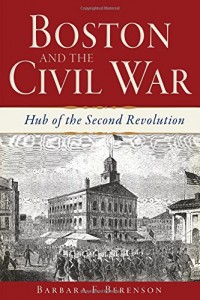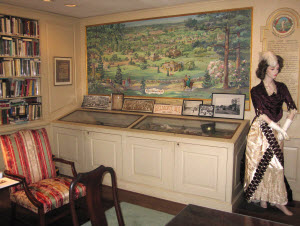Outdated Content
The Belmont Historical Society is joining with the Belmont Public Library, the Belmont Garden Club, the Belmont Library Foundation, and the Friends of The Belmont Public Library in sponsoring a respite from winter. Spring will bloom early in Belmont this year: the library’s sesquicentennial celebration begins with “Books In Bloom”, an exhibit of more than 20 floral interpretations of popular books, to be held the weekend of March 2 – 4 at the library. The celebration begins with Friday night’s “First Look” opening party on March 2 from 7:00 – 9:00 in the library when the floral designers reveal their creations. Be the first to see these original floral interpretation of books at their freshest, displayed throughout the building. Enjoy wine, beer and light refreshments, meet friends, and listen to music as you stroll through the exhibits. Tickets are $20 in advance, $25 at the door, available now at the Belmont Public Library, Belmont Books (in Belmont Center), the Beech Street Center, and online through Eventbrite.
All remaining events on Saturday and Sunday are free and open to the public. On Saturday, March 3, from 10:00 am to 4:00 pm, the Belmont Historical Society will open the doors to its historic Claflin Room in the library. Come learn about the history of Belmont as well as the history of the library via a continuous media display. See some of Belmont’s many historic artifacts housed in the Claflin Room and learn many fun facts about Belmont history from members of the Society.
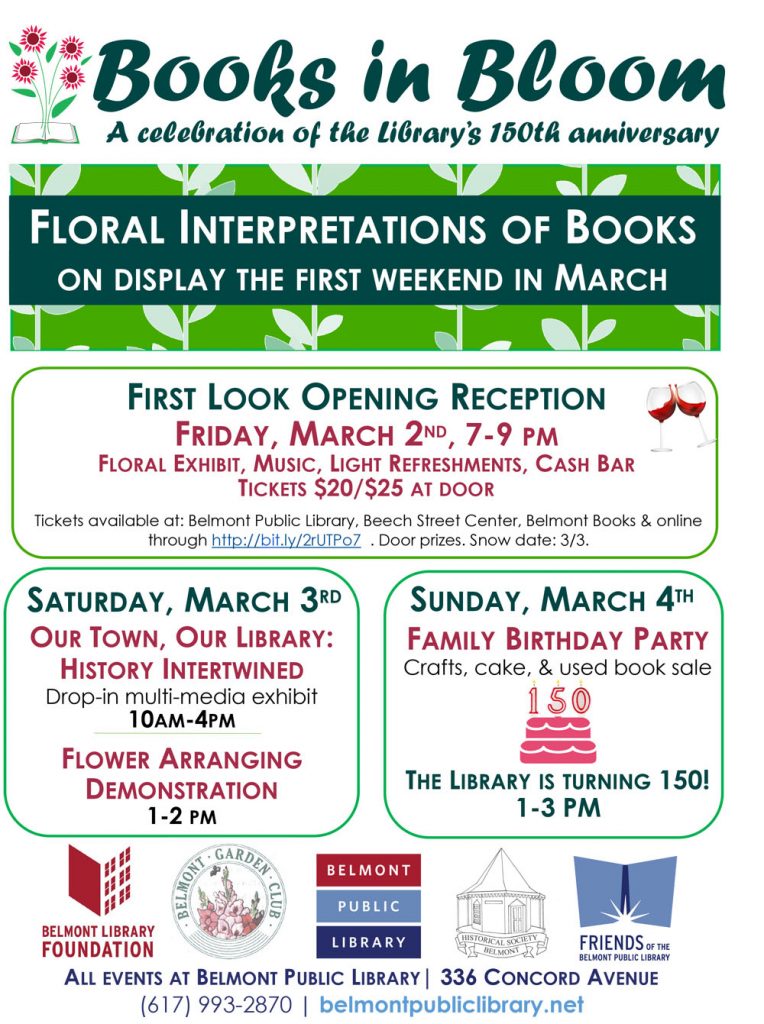
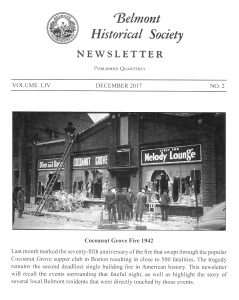
Newsletter The most recent issue of our quarterly newsletter (December 2017) was mailed to all members of the Society in January. This newsletter is devoted to Belmont’s connections to the disastrous fire that occurred in the Cocoanut Grove supper club in Boston 75 years ago on November 28, 1942. That was the second deadliest single building fire in American history and claimed nearly 500 lives. The newsletter recounts the stories of the Belmont residents who perished in the fire, those who were in the building but survived, and those who responded from Belmont to help remove the victims from the ruins and care for the survivors.
Coming Events
Belmont Historical Society’s
Holiday Open House
Wednesday, December 6, 2017, 7:00-8:30 pm
Claflin Room, Belmont Memorial Library
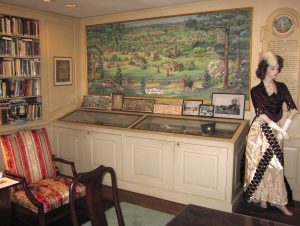
The Belmont Historical Society invites the public to its Holiday Open House on Wednesday evening, December 6, from 7:00 to 8:30 pm in the Claflin Room of the Belmont Memorial Library. The Claflin Room is the Historical Society’s home and houses its extensive collection of documents, images, and artifacts associated with the town’s history. The Open House will be an opportunity to see some items from the collections; learn interesting facts about Belmont’s history; chat with friends, neighbors, and officers of the Society; and enjoy some refreshments and holiday music. Books and other items related to Belmont will also be available for purchase if you would like to do some holiday shopping. Admission is free – stop by for a few minutes or spend the evening.
Jordan Marsh: Boston’s First Department Store
Anthony M. Sammarco, Author
Sunday, November 5, 2017, 2:00-4:00 pm
Assembly Room, Belmont Memorial Library
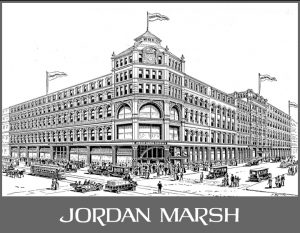
In 1851 Eben Dyer Jordan and Benjamin L. Marsh opened their first store — Jordan Marsh — on Milk Street in Boston selling linen, silk, calicos, ribbons and assorted dry goods to Victorian Bostonians. Following the Civil War, the store moved to Winthrop Square and later to Washington Street between Summer and Avon Streets where they unveiled the novel concept of “department shopping” under one roof in a new five-story building. Through the late 19th century and into the 20th, Jordan Marsh offered a growing selection of goods ranging from clothing to furniture, children’s toys, and many other items that attracted shoppers six days a week. The store offered personal service with the adage that “the customer is always right”, easy credit, art exhibitions, and musical performances. However, perhaps the most memorable offerings from Jordan Marsh were the blueberry muffins from the bakery department and the “Enchanted Village of Saint Nicholas”, an expansive animated Christmas display that attracted throngs of children (and adults) each holiday season. By 1951 Jordan Marsh expanded to the suburbs with its first store at Shopper’s World in Framingham, and by the 1970’s it was the largest department store chain in New England. By then, however, mergers and acquisitions had begun to change the retail landscape, and Jordan Marsh was sold and the Macy’s name went up on Jordan Marsh stores in 1995. Incidentally, the Macy’s department store that was in Belmont Center for many years until it closed in 2013 traces its ancestry to Filene’s department stores, not Jordan Marsh. Filene’s was a major competitor to Macy’s until the Filene’s chain was acquired by Macy’s parent company in 2005 and the remaining Filene’s stores were renamed Macy’s.
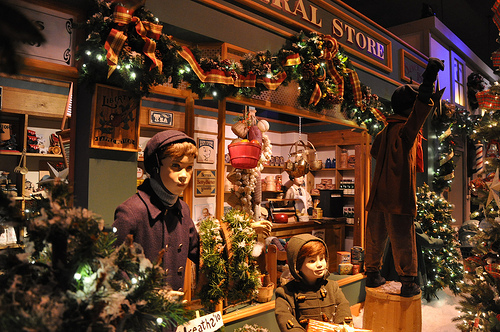
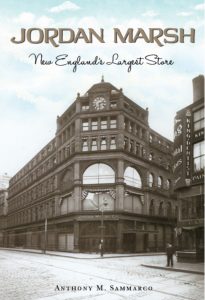
Anthony Mitchell Sammarco is a noted historian and the author of over 60 books on the history and development of Boston, and he lectures widely on diverse subjects from Boston’s history. His most popular books include Lost Boston; The History of Howard Johnson’s: How A Massachusetts Soda Fountain Became a Roadside Icon; The Baker Chocolate Company: A Sweet History; Boston’s Back Bay in the Victorian Era; Dorchester: Volume II, Dorchester Then & Now; Boston’s North End (also available as Il North End di Boston in Italian); and the Great Boston Fire of 1872. Anthony’s most recent book is the just-published Jordan Marsh: New England’s Largest Store. Since 1997 he has taught at The Urban College of Boston where his courses led to him being named Educator of the Year. He has received the Bulfinch Award from the Doric Dames of the Massachusetts State House and the Washington Medal from the Freedom Foundation. Anthony was named Dorchester Town Historian by Raymond L. Flynn, mayor of Boston, for his work in history. He was elected a fellow of the Massachusetts Historical Society and is past president of the Bay State Historical League and the Dorchester Historical Society.
This illustrated lecture on Boston’s first department store at 2:00 pm on Sunday, November 5, 2017 in the Assembly Room of the Belmont Memorial Library is free and open to the public, and refreshments (including blueberry muffins from the authentic Jordan Marsh recipe) will be served.

The Metal Art of Abraham Megerdichian
Curated by Robert Megerdichian
Sunday, October 22, 2017, 2:00-4:00 pm
Assembly Room, Belmont Memorial Library
Abraham Megerdichian, a native of Cambridge, worked as a machinist for General Electric in Lynn in the 1950’s. During his lunch breaks, he would rummage through the scrap bins, salvaging scraps of metal, and eventually turning those scraps of metal into a wonderful collection of over 300 miniature metal pieces of art.
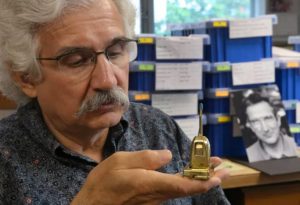
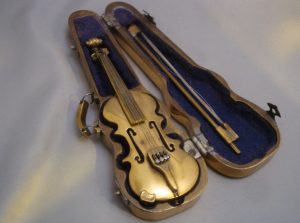
In 1983, at the young age of 59, Abraham passed away and his collection of miniatures was packed away. It wasn’t until 20 years later that his son, Robert, rediscovered his father’s extraordinary collection of miniature metal art. As a tribute to his Dad and a way for his own two sons to get to know the grandfather they never knew, Robert began sharing his father’s collection at local museums and various other venues. Robert and his father’s collection have been featured in the Boston Globe and on WCVB Channel 5’s Chronicle program. Click here to view the three-minute video clip of Robert’s appearance on Chronicle in 2016. Click here to read the article in the June 27, 2016 issue of the Globe. Now, Robert will be sharing his father’s remarkable collection of miniature metal art with us here in Belmont on Sunday, October 22, 2017. This program is free and open to the public. Refreshments will be served.
Programs The second program in our 2017-2018 series of monthly programs will be presented on Sunday, November 5 with an illustrated talk about Jordan Marsh: Boston’s First Department Store. The first Jordan Marsh store was established in downtown Boston in 1851, and the company grew and prospered into the 20th century until by the 1970’s it was the largest department store chain in New England. By then, however, bankruptcies, mergers, and acquisitions began to change the retail landscape, and the remaining Jordan Marsh stores were converted into Macy’s stores in 1996. The Boston area historian and author Anthony Sammarco will present a free illustrated lecture in the Assembly Room of the Belmont Memorial Library at 2:00 pm on Sunday, November 5. More information is available on our Coming Events page. You may also watch streaming videos of many of our recent programs through the courtesy of the Belmont Media Center — the links are on the Recent Events page.
[slideshow_deploy id=’2847′]
Tour of the Historic Royall House in Medford
Saturday, October 1st, 11:00 am – 1:00 pm
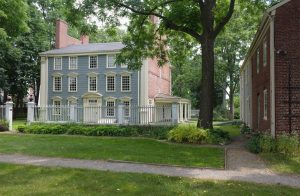
The first program in our 2016-2017 season will be a guided tour of the historic Royall House in Medford. In 1732 Isaac Royall, Sr. purchased 504 acres of land in what was then Charlestown (now Medford). This land was visible from several points along the Mystic River and straddled a major thoroughfare linking Boston with towns to the north. In 1737 the Royalls moved to their new home from their sugar plantation in Antigua in the West Indies. They brought with them 27 African slaves whose labor was essential to maintaining the estate. An elm-lined drive led to the imposing neoclassical mansion at the heart of the property. While most eighteenth-century New Englanders relied upon their land for food, the Royall estate featured ornamental plantings and well-tended lawns in addition to orchards and pastures for sheep and cattle. A central feature of the site is the only known extant separate slave quarters in the northern United States. In 1750 a traveler described “a fine country seat belonging to Mr. Isaac Royall, being one of the grandest in North America.” This carefully constructed landscape was designed both to impress and to illustrate the imposition of man’s will upon nature. The opulent display demonstrated the family’s rise in fortune and status from indentured servants to wealthy landowners in two generations.
After Isaac Royall Jr. fled to England at the outbreak of the Revolutionary War, the Massachusetts General Court confiscated his estate. The mansion was used during the early months of the Revolution by Generals Lee, Stark, and Sullivan, and was visited by George Washington who, according to legend, interrogated two British soldiers in the Marble Chamber. After the Revolution, Washington’s secretary, Colonel Cary, lived in the house for two years and in 1790 William Woodbridge kept a boarding and day school in the house. In 1804 the estate was returned to Isaac Royall Jr.’s heir, his granddaughter Elizabeth (Royall) Hutton, who sold the estate to Robert Fletcher for £16,000 in 1806.
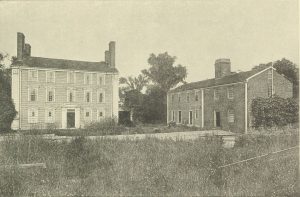
By the end of the 19th century the house had passed through several hands and had fallen into disrepair. In 1898, the Sarah Bradlee Fulton Chapter of the Daughters of the American Revolution conceived the idea to preserve the Royall House “for the sake of its history and aesthetic value.” On Patriots Day in 1898, they opened up the house to the public for a Loan Exhibition of colonial furnishings and valuable relics. In 1907 this group of women recruited a wider group of “patriotic men and women” and formed the Royall House Association. The group’s initial mission was to raise the necessary funds ($10,000) to purchase the house, the slave quarters and three-quarters of an acre of surrounding land to be maintained as a museum, which they ultimately were able to do in April 1908. A number of interior and exterior restorations of the buildings and site have been conducted over the years, and in 1962, the Royall House was designated a National Historic Landmark. Today the Royall House Association (RHA) owns and operates the Royall House and Slave Quarters as a museum and educational resource, with seasonal tours, a public program series and more. More information about the Royall House is available at www.royallhouse.org.
Sunday afternoon, April 24, 2016
2:00 – 4:00 pm
“The Massachusetts Audubon Society’s Habitat Education Center and Wildlife Sanctuary in Belmont”
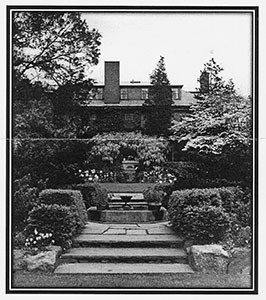
This program will be held at the 90-acre Habitat property located at 10 Juniper Road in Belmont. Sharon Vanderslice, a volunteer at Habitat, will present the history of the property from colonial times to the present and highlight Ruth (Hornblower) Atkins Greenough Churchill who left her Georgian Revival style home and the surrounding estate to be used for environmental education. Following the talk, Habitat Director Roger Wrubel will lead a tour of the house and formal gardens. The Habitat trails will be open to explore on your own.
“One Woman, One Vote: The New Woman and the New Century”
Barbara Berenson, Attorney and Historian
Tuesday, April 12th, 2016
Our next program will be on Tuesday evening, April 12th, 2016 in the Assembly Room of the Belmont Public Library. Barbara Berenson will speak on One Woman, One Vote: The New Woman and the New Century, drawing upon her research for a forthcoming book about the woman suffrage movement in Massachusetts. All of our programs are open to the public and most of them are free, and refreshments will be served. Barbara Berenson will speak about the woman suffrage movement in Massachusetts during the late 19th and early 20th centuries. Barbara is an attorney and a historian who spoke about “Boston and the Civil War: Hub of the Second Revolution” at the Society’s recent program in November 2015. This free lecture about the woman suffrage movement is being presented as part of the “One Book One Belmont” program organized by the Belmont Public Library with the Belmont Historical Society again a co-sponsor. Anita Diamant’s best-selling novel The Boston Girl has been selected as the featured title for One Book One Belmont 2016, the library’s sixth town-wide reading program. The Boston Girl explores the environment and experiences of women immigrants in Boston during the early part of the 20th century, with woman suffrage as one of the major changes. Click here to see the poster for Barbara Berenson’s lecture.
Tuesday, April 12, 2016
7:30 – 9:00 pm
Assembly Room, Belmont Public Library
Refreshments will be served
Holiday Music with Vanessa Schukis
plus
Presentation of Historic House Plaques
 Come and enjoy this joyous holiday season with music performed by Vanessa Schukis, mezzo-soprano and pianist who will perform lesser-known carols as well as familiar ones that we can all sing along with. Ms. Schukis teaches voice and is on the faculty of the Powers Music School in Belmont. She has had a multi-faceted career as a character mezzo, actress, choreographer, stage director, vocal coach, educator, and administrator.
Come and enjoy this joyous holiday season with music performed by Vanessa Schukis, mezzo-soprano and pianist who will perform lesser-known carols as well as familiar ones that we can all sing along with. Ms. Schukis teaches voice and is on the faculty of the Powers Music School in Belmont. She has had a multi-faceted career as a character mezzo, actress, choreographer, stage director, vocal coach, educator, and administrator.
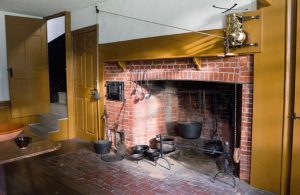 Prior to the musical program, the Belmont Historical Society will recognize and celebrate some historic Belmont homes by distributing its most recent group of Historic House plaques. There will also an opportunity to do some holiday shopping as the Society offers for sale the new updated edition of the book The Streets of Belmont and How They Were Named as well as other Belmont-themed items such as books, DVDs, scenic and historic note cards, and more.
Prior to the musical program, the Belmont Historical Society will recognize and celebrate some historic Belmont homes by distributing its most recent group of Historic House plaques. There will also an opportunity to do some holiday shopping as the Society offers for sale the new updated edition of the book The Streets of Belmont and How They Were Named as well as other Belmont-themed items such as books, DVDs, scenic and historic note cards, and more.
Sunday, December 6, 2015 @ 2-4:00 pm
Location: Assembly Room, Belmont Memorial Library
Holiday refreshments will be served
Free
“Boston and the Civil War: Hub of the Second Revolution”
Barbara Berenson, author
Barbara Berenson introduces her recent book with the following overview: “Most people know that the American Revolution began in Boston when a group of radical activists protested British governance of the colonies. But many people don’t know that the nation’s Civil War – the war that ended slavery – also began in Boston. Led by agitator and publisher William Lloyd Garrison, a group of radical abolitionists protested against Southern slavery and Northern acquiescence in the South’s ‘peculiar institution’. Guided by the example of Revolutionary-era Patriots who persuasively argued for independence while organizing dramatic protests such as the Boston Tea Party, Boston’s black and white activists organized an unrelenting campaign against slavery and racism. As the antislavery movement grew, Southern slaveholders became more determined than ever to resist any proposals that would limit the spread of slavery. After Northerners elected Abraham Lincoln to the presidency in 1860, eleven Southern states seceded from the Union. When Lincoln went to war to restore the Union, Boston’s abolitionists tirelessly campaigned for expanding the aims of the war to include the permanent elimination of slavery. They led a Second American Revolution intended to force the nation to live up to the promises of liberty and equality contained in the Declaration of Independence.”
To learn more about this important period in Boston’s history, join us on November 22nd. Barbara Berenson is a lawyer (Harvard College and Harvard Law School) and works as a Senior Attorney at the Massachusetts Supreme Judicial Court. She has also written the guidebook Walking Tours of Civil War Boston: Hub of Abolitionism
Sunday, November 22 @ 2-4:00 pm
Location: Assembly Room, Belmont Memorial Library
Free
Refreshments will be served
Feedback We appreciate the feedback that we received from those of you who responded to our survey using either the interactive online form available on this website or the paper form that was mailed to all members. One of the suggestions that we received concerning our website was that we provide a brief overview of the history of the town of Belmont.
To learn more about this important period in Boston’s history, join us on November 22nd. Barbara Berenson is a lawyer (Harvard College and Harvard Law School) and works as a Senior Attorney at the Massachusetts Supreme Judicial Court. She has also written the guidebook Walking Tours of Civil War Boston: Hub of Abolitionism
That was a welcome suggestion, and we have done it. We have added a new item (“Belmont History”) to our main menu with two drop-down sub-items: a “Brief History” page, and our “Historic Happenings” page which was formerly included on the main menu. Please take a look. We hope to add more interesting content about the town’s history in the near future, so check back occasionally. Also, please feel free to use our online survey form at any time to offer your opinions and suggestions.
Second Graders To Explore Belmont History
On the morning of Friday November 1st the Belmont Historical Society will host second grade classes from the nearby Wellington School. This annual event takes place each fall and is held in the Claflin Room at the Belmont Memorial Library where the students can encounter the unique history of the Town of Belmont first hand.
The visit begins with a presentation that includes photographs, art, and a variety of donated objects which challenge the young audience to consider what life was like in the rural farm community at the time of the town’s incorporation. Questions such as: How did the town get its name? Who is the Wellington School named after? What is the oldest continuous business that began back in 1876? and When was the town incorporated? are all answered in this fast-paced interactive session.
Next, volunteer members of the Belmont Historical Society showcase “old fashion” everyday items that were in use only a few short decades ago but are now obsolete. Glass milk bottles left outside after home delivery, wire rug beaters to clean the dirt from carpets, and metal wash boards to scrub cloths clean provoke lots of guesses from the audience raised in a world of modern technology.
Finally, the volunteers on hand are also able to highlight dozens of items on display in the Claflin Room which are part of the archival collection before they give the students time on their own to explore.
Holiday Music
Sunday, December 14, 2014
Come and enjoy this joyous holiday season with music performed by Vanessa Schukis, mezzo-soprano and pianist who will also perform lesser-known carols on the flute and will invite us all to join in a sing-along. Ms. Schukis teaches voice and is on the faculty of the Powers Music School in Belmont. She has had a multi-faceted career as a character mezzo, actress, choreographer, stage director, vocal coach, educator, and administrator. She has been a soloist/section leader for the historic Old North Church in Boston’s North End for 26 years and a soloist/cantor for 15 years at St. Paul’s church in Wellesley. She continues to perform in theater, opera, and concert engagements throughout the United States. Here in Red Sox Nation, she has sung the National Anthem and “God Bless America” at a Boston Red Sox game. Vanessa has been a member of the guest faculty at the New England Conservatory and a visiting faculty member at the Longy School of Music in Cambridge.
Prior to the musical program, the Belmont Historical Society will recognize and celebrate historic Belmont homes by distributing its bi-annual Historic House plaques. After the musical program the Society will offer for sale the new updated edition of the book The Streets of Belmont and How They Were Named as well as other items associated with the town.
“Women Reformers: A Walking Tour of
Mount Auburn Cemetery”
Sunday, September 27 @ 1:00 pm

Mount Auburn Cemetery in Cambridge was founded in 1831 for two reasons: to solve an urban space problem created by the increasing number of burials in the city, and to create a tranquil and beautiful place where families could commemorate their loved ones in an inviting and natural setting. The new Mount Auburn Cemetery quickly became the model for the American “rural” cemetery movement.
Today Mount Auburn continues its historic dual role as a sacred burial site and a peaceful retreat for the living, serving as both an active cemetery and a “museum” preserving nearly two centuries of changing attitudes and changing tastes in architecture and landscape design. Recognized as one of the most significant designed landscapes in the country, Mount Auburn Cemetery was listed on the National Register of Historic Places in 1975 and was designated a National Historic Landmark in 2003. Much more information about Mount Auburn Cemetery is available at the website of the Friends of Mount Auburn.

Many famous people from all walks of life are buried at Mount Auburn Cemetery, and burials continue there today. Our walking tour will celebrate women reformers in education, politics, health care, civil rights, and social causes. Margaret Fuller, Julia Ward Howe, Dorothea Dix,and many other notable women are buried there.
Sunday, September 27 @ 1-2:30 pm
Location: Mt. Auburn Cemetery, Cambridge (meet inside the main entrance gate on Mt. Auburn Street)
Fee: $12 (to help cover the fee for an expert guide)
Note: Space is limited, so please register in advance by calling (617) 993-2878
“Massachusetts’ Role in the 19th Century
China Trade”
Doug Stewart, Ipswich writer
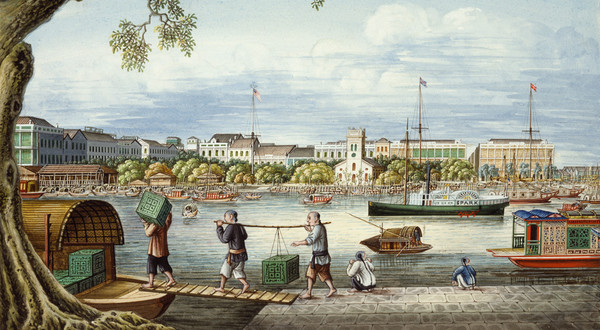
Thursday, October 22 @ 7:30-9:00 pm
Location: Assembly Room, Belmont Memorial Library
Free, refreshments will be served
blah blah blah Royall House blah blah blah

